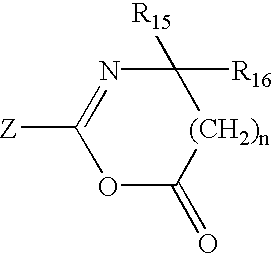Delivery of reactive agents via multiple emulsions for use in shelf stable products
a technology of reactive agents and emulsions, applied in the direction of drug compositions, hair cosmetics, impression caps, etc., can solve the problems of severely or completely reducing the reactive effect of aqueous compositions, and achieving problematic results
- Summary
- Abstract
- Description
- Claims
- Application Information
AI Technical Summary
Benefits of technology
Problems solved by technology
Method used
Image
Examples
examples
[0148]The following examples further describe and demonstrate various embodiments within the scope of the present invention. The examples are given solely for the purpose of illustration, and are not to be construed as limitations of the present invention since many variations thereof are possible without departing from its spirit and scope. In the examples and throughout the present specification, parts and percentages are by weight unless otherwise indicated. Ingredients are identified by chemical or CTFA name, or otherwise defined below.
[0149]The oil-in-oil-in-water (O1 / O2 / W) multiple emulsion treatment compositions of the present invention typically are prepared by a two step process. First, the reactive agent is solubilized within a suitable (O1) oil / solvent and then the (O1) oil / solvent comprising the reactive agent is emulsified within a suitable oil (O2) to form the primary oil-in-oil emulsion (O1 / O2). In preparing the primary oil-in-oil emulsion (O1 / O2), the (O2) phase part...
examples i-vi
[0153]The following Examples I-VI describe primary oil-in-oil emulsion compositions (O1 / O2) used to prepare the multiple emulsion treatment compositions (O1 / O2 / W) of the present invention. All weight percentages in the following table are based on the total weight of the primary oil-in-oil emulsions (O1 / O2).
[0154]
TABLE IPrimary Emulsion Compositions (O1 / O2)IngredientIIIIIIIVVVIReactive AgentsPolymer I (6)5.05.05.05.0——Polymer II (7)————5.0—Conditioner III (8)—————5.0(O1) Phase Oils / SolventsD5 Cyclomethicone (9)45.0——45.045.045.0Propylene Carbonate (10)—45.045.0———(O2) Phase OilsSoybean Oil (11)—45.045.0———SEFA soyate / cottonate (12)45.0——45.045.045.0(O2) Phase ThickenersTri-12-hydroxystearin (13)5.05.0——5.05.0Silica dimethyl silylate (14)——5.0———quaternium-18 hectorite (15)———5.0——100.0100.0100.0100.0100.0100.0(6) Polymer 1 is as described herein, the preparation of which can be referenced in U.S. Ser. No. 09 / 478,855 by R. Glenn et. al. (7) Polymer 2 is as described herein, the prepa...
PUM
| Property | Measurement | Unit |
|---|---|---|
| boiling point | aaaaa | aaaaa |
| particle size | aaaaa | aaaaa |
| particle size | aaaaa | aaaaa |
Abstract
Description
Claims
Application Information
 Login to View More
Login to View More - R&D
- Intellectual Property
- Life Sciences
- Materials
- Tech Scout
- Unparalleled Data Quality
- Higher Quality Content
- 60% Fewer Hallucinations
Browse by: Latest US Patents, China's latest patents, Technical Efficacy Thesaurus, Application Domain, Technology Topic, Popular Technical Reports.
© 2025 PatSnap. All rights reserved.Legal|Privacy policy|Modern Slavery Act Transparency Statement|Sitemap|About US| Contact US: help@patsnap.com



